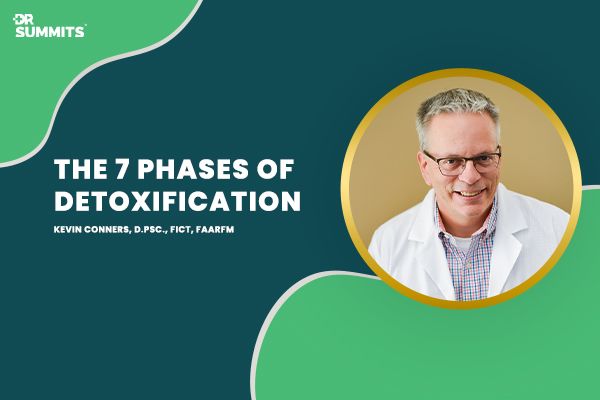Join the discussion below
Long COVID symptoms and recovery
One integrative health expert shares her story of long COVID recovery
Two years into the pandemic, doctors and researchers continue to study why some patients with no other comorbidities recover completely from COVID-19, while others suffer from long COVID. Lingering symptoms can last for weeks or months after contracting COVID-19, leaving many feeling hopeless about long COVID recovery. Experts have coined a new term for it: post-acute sequelae SARS-CoV-2 infection (PASC).
For one fit and health conscious integrative health expert, Jessica Drummond, DCN, CNS, PT, the research became personal when she became a COVID long hauler. Drummond has worked for 25 years as founder of the Integrative Women’s Health Institute, helping women with chronic illness.
Her deep knowledge of chronic illness was invaluable in her own journey to long COVID recovery. On Christmas morning of 2020, 46-year-old Drummond was on day nine of what had been a mild COVID-19 infection. That day, though, she says, “Something shifted, and I literally just couldn’t breathe. It was as if someone poured hot tar in the lower parts of my lungs, and my resting heart rate just skyrocketed into the 130s and the 150s.”
She headed to the hospital for steroids, hydration and IV fluids. Drummond says she was surprised by her body’s sudden severe reaction to COVID-19. “I was in a really good place to confront this virus from a host resilience standpoint.”
Drummond’s COVID-19 story didn’t end after that initial two weeks of acute infection. She presented with post-COVID pericarditis that required three months of medical treatment, ibuprofen, colchicine and rest to recover from long COVID. “I was one of those people who didn’t get better after two weeks. I went right on into my long haul experience.”
What is long COVID or PASC?
Long COVID is defined as the presence of various symptoms weeks or months after acquiring SARS-CoV-2 infection, irrespective of the viral status. It’s continuous or relapsing and remitting in nature. Post-COVID-19 conditions occur in individuals with a history of probable or confirmed SARS-CoV-2 infection. A patient is considered to have a diagnosis of long COVID when symptoms last for at least two months and cannot be explained by an alternative diagnosis.
Common symptoms of long COVID
There are typically two patterns of symptoms in people with long COVID. One is fatigue, headache and upper respiratory complaints (shortness of breath, sore throat, persistent cough and loss of smell). The other is multi-system complaints, including ongoing fever and gastroenterological symptoms.
Symptoms of long COVID generally have an impact on everyday functioning.
Drummond experienced many of these symptoms, including:
- Air hunger due to difficulty perfusing her cells at the cellular level with oxygen
- Constant full-body burning vascular pain
- Brain fog and reduced cognitive endurance
- Visual changes
- Elevated resting heart rate, reduced heart rate variability and dysautonomia
- Exercise intolerance

Some patients, like Drummond, have COVID symptoms that never go away following acute infection. Others fully recover, return back to their lives – albeit a little tired or short of breath – and then a few weeks to a few months later present with long COVID symptoms. There can be the persistence of one or more symptoms of acute COVID or the appearance of brand new symptoms. The time lag between the microbiologic recovery – once a PCR test is negative – and clinical long COVID recovery can vary.
Why long COVID happens
It’s not clear why long COVID happens to some patients and not others. However, some people are at a higher risk for long COVID. Females ages 35 to 64 with a history of allergies or atopic conditions are at higher risk for long COVID.
In males there’s a higher risk of severe illness and death from COVID-19. In women, there’s less risk of severe illness and death but a higher risk of specific autoimmune activation.
There also can be serious organ injury, even in very mild presenting cases in individuals at low risk of COVID-19 mortality – younger people who are not obese, have no metabolic syndrome issues, no asthma or other preexisting conditions.
One root cause of long COVID for some patients is that there’s actual organ damage from the initial infection, such as heart, kidney, pancreatic, immune system or brain issues. According to a March 2021 study by Andrea Dennis, Malgorzata Wamil and colleagues, “In individuals at low risk of COVID-19 mortality with ongoing symptoms, 70 percent have impairment in one or more organs four months after initial COVID-19 symptoms.”
Long COVID exercise intolerance symptoms may be caused by damage to the skeletal muscles
Exercise intolerance from long COVID may be caused by cellular damage in the actual skeletal muscles. These cellular level changes of skeletal muscles post COVID-19 infection resemble heart failure in the cardiac muscle.
While this is not being seen in long COVID cardiac muscles, it is seen in skeletal muscles. This explains why Drummond still struggled with exercise fatigue even after fully recovering from her initial bout of pericarditis. Her lung function tests and oxygenation looked fine all along. The problem was that the oxygen at the level of the capillaries was not perfusing into the cells normally and instead circulating right back up to the heart and lungs.
This triggers hyperventilation, or a breathing pattern disorder, which lowers carbon dioxide levels. This makes it even harder for cellular oxygen uptake and causes lowered filling pressures on the left side of the heart. This can change blood pressure and reduce the ability for people to be active upright without fatiguing.
One of the theories why this happens is that where arterial and venous capillaries are meeting at the cellular level, they’re innervated by small nerve fibers. That helps capillaries vasodilate and vasoconstrict without you having to consciously think about it. Research out of South Africa and Germany has shown that essentially 100 percent of long COVID patients they’ve studied have tiny micro clots that could be gumming up the works and triggering a small fiber neuropathy locally. This makes it harder for those nerves to function correctly.
How to improve exercise tolerance for long COVID recovery
Drummond says nutrition and a cautious return to exercise is key to supporting the peripheral neurons with nerve and mitochondrial nourishing nutrition. “We can learn a lot from things like concussions and also from nutritional treatment to support Epstein-Barr virus or any other mitochondrial dysfunction. We also see this in diseases like fibromyalgia.”
Exercise is not a form of treatment for COVID long haulers. While getting back to exercise is a goal for many patients, forcing it can extend the problem. Drummond says, “As people heal, their window of energy each day expands, and they can start doing more. This is good for these patients in general, but it’s not a treatment to actually fix mitochondrial function. Exercise when they’re hypoxic, essentially at the cellular level is going to actually exacerbate the condition.”
This is because a person with long COVID would be forcing the body to perform certain functions at the cellular level that would be aerobic to do them anaerobically. This is difficult and stressful to the system. Instead, the patient needs to save that anaerobic action for things that are necessary for survival.
A better plan is to practice movement in horizontal positions, such as Pilates moves or dysautonomia exercise protocols that can help train the autonomic nervous system (ANS) to start gently functioning more appropriately in terms of vasodilation, vasoconstriction and heart rate regulation. This is better than strength training or endurance training.
Why rest can improve long COVID symptoms
Research shows it’s not uncommon for a long COVID patient to experience something like postural orthotic hypertension (POTS) or other dysautonomia conditions. This means that healing ANS signaling and toning the vagus nerve is important for long COVID recovery. The abrupt health shift and uncertainty that comes with long COVID can cause the sympathetic nervous system activation of fight, flight, freeze for good reason. That state makes it harder for the body to heal. Focusing on rest, digest and heal will retrain that ANS to spend more time in parasympathetic activation.
The ANS actually triggers sickness symptoms to encourage the human organism to rest. Rest is what the body needs to heal those mitochondria, to calm inflammation and resolve the infection.
Why long COVID causes brain fog
Dysfunctional brainstem signaling may be an important driver of long COVID symptoms. The functions of the vagus nerve align with the most common symptoms of long COVID.
The vagus nerve does some of the following:
- Sensory: Innervates the skin of the external acoustic meatus and the internal surfaces of the laryngopharynx and larynx. Visceral sensation to the heart and abdominal viscera, which explains why some patients with long COVID experience heart rate irregularities, slowed gut motility, SIBO and bloating.
- Special Sensory: Provides taste sensation to the epiglottis and root of the tongue, which helps to explain why people with long COVID can’t taste or instead can’t tolerate certain tastes.
- Motor: Provides motor innervation to the majority of the muscles of the pharynx, soft palate and larynx, which explains why dysphagia is common with long COVID.
- Parasympathetic: Innervates the smooth muscle of the trachea, bronchi and gastrointestinal tract and regulates heart rhythm. It controls the smooth muscles of the esophagus, gallbladder, pancreas, and small intestine, stimulating peristalsis and gastrointestinal secretions.
Research from Daniel Chertow et al shows, “Our findings, therefore, suggest viremia leading to body-wide dissemination, including across the blood-brain barrier, and viral replication can occur early in COVID-19, even in asymptomatic or mild cases.”

This means that a person may have had an asymptomatic or mild case, but the virus has snuck into the brain and started replicating there, infecting the brain tissue directly. This is why some people experience cognitive issues such as brain fog, reduced cognitive endurance and even dementia-like presentations.
How to treat long COVID
Just like with every chronic illness, key to long COVID recovery is to optimize systems rather than chase down symptoms. Drummond says a good starting point is with the nervous system and vascular system, and then quickly roping in the digestive system concurrently.
The oral microbiome of patients with prolonged symptoms of long COVID show a dysbiotic pattern of increased pathobionts. Those are essentially viruses that can infect the gut bacteria and increase inflammation-inducing and LPS-producing microbiota. Gut persistence can last for months post-infection, which could keep triggering a pathologic immune response.

Improving the gut biome with probiotics could help eliminate COVID from being such a problematic factor. The probiotics species will depend on each person’s bacterial irregularities.
Cardiovascular and pulmonary healing for long COVID recovery
Drummond says the most distinctive experience of long COVID for her was a sensation of her entire vascular system feeling like it was on fire. “I could almost imagine all the vessels through my body.”
Days after her second mRNA vaccine dose, that pain cleared. After her first vaccine dose, her heart rate stabilized. The links between COVID-19 and vascular pain weren’t clear at the time Drummond experienced it in early 2021, but new research is showing that potential therapies that address vascular system dysfunction and its sequelae may have an important role in treating COVID-19 and long COVID.
Drummond’s deep knowledge of chronic disease meant she was more empowered to treat her own symptoms by what she calls “optimizing the system.”
She says the key is to keep inflammation low, nourish the vascular epithelium and the small fiber neurons, regulate the autonomic nervous system, and keep studying the vagus nerve.
Drummond says, “What’s gumming up the works is still in discussions from a research standpoint, but we can still use our functional nutrition strategies to help clearing and cleaning the blood to keep kind of resetting the nervous system and the immune system to clear any persistent virus or viral proteins of the virus.”
How to treat fatigue from long COVID symptoms
One of the most common symptoms of long COVID is fatigue. Drummond says, “Any time I think of fatigue, I start to think about what’s going on in the mitochondria.”
Numerous studies are looking to understand the role that mitochondria, oxidative stress and antioxidants may play in the understanding of the pathophysiology and treatment of fatigue that comes with long COVID.
Drummond says, “There are lots of medical therapies under consideration, all of which I think are really important to keep in mind. We want to be integrative, and there’s some real value here in some of these medical therapies. But what we can do with our tools in functional medicine is help people use what we know now to start actively healing patients.”
Drummond recommends the following for long COVID recovery:
- Exercises that strengthen the autonomic nervous system, such as breath work and Pilates.
- A low-carb, plant-based diet
- Good quality animal protein
- Intermittent fasting
- Convalescence time for recovery and pacing the return to work and exercise
As Drummond’s story shows, long COVID is challenging, even traumatic, and it happens to people who were very healthy before their COVID infection, as well as people with comorbidities. There’s absolutely hope for complete recovery from long COVID, though, it might take a little while for many people.
Drummond says, “That hope is really important and vigorously needed right now because people with long COVID after a year or almost two years are becoming a bit hopeless.”
Jessica Drummond, DCN, CNS, PT is founder of the Integrative Women’s Health Institute. She’s worked with women with chronic illness for 25 years, most specifically, endometriosis, vulvodynia and other chronic pelvic pain conditions. You can find her on Instagram @integrativewomenshealth.








